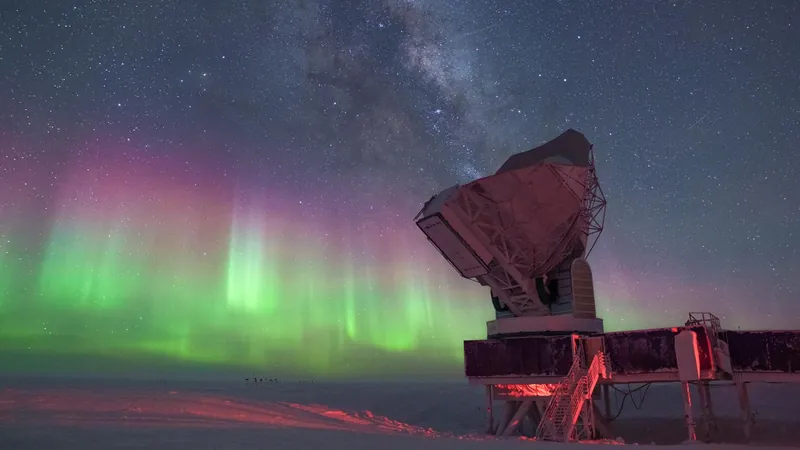
A Revolutionary Insight into the Universe's Earliest Light: Are We Facing a Cosmic Conundrum?
2024-11-15
Author: Mei
Introduction
In the breathtaking infancy of our Universe, it was a wild and chaotic scene—photons, the very essence of light, were ensnared in a tumultuous sea of ionized gas, colliding randomly with the fiery nuclei and electrons populating the cosmic fireball. This spectacular dance between particles continued for approximately 370,000 years after the Big Bang. Slowly, as the Universe expanded and cooled, the conditions became just right for these photons to break free. After one final scattering, they embarked on their unprecedented journey through 14 billion years of space and time, eventually gracing Earth as the cosmic microwave background (CMB), a celestial remnant of creation itself.
CMB and Its Significance
The CMB constitutes one of the strongest frameworks substantiating the Big Bang theory and the standard model of cosmology. By scrutinizing fluctuations in the CMB, astronomers can unravel key cosmic mysteries—these include the shape of the Universe, the distribution of matter and energy, and the increasingly contentious rate of cosmic expansion. The latter issue has given rise to what astronomers are now calling the "Hubble tension problem."
Measuring the Hubble Parameter
Currently, astronomers utilize two primary methodologies to measure the Hubble parameter—the cosmic speed limit, so to speak. The first is based on observations of the CMB, while the second draws from various astrophysical phenomena, notably supernovae. Herein lies the dilemma: the two methodologies deliver contradictory results. These disparities suggest possible underlying flaws in the standard model of cosmology.
Challenges with CMB Observations
The CMB observations, despite their significance, are somewhat hampered by limited data. High-quality measurements primarily originate from space telescopes like Planck, which meticulously quantified fluctuations in CMB intensity. Some scientists have posited that biases might be at play in CMB observations. However, groundbreaking new data from the South Pole Telescope (SPT) challenges this notion.
Polarization as a New Metric
Instead of observing intensity fluctuations, the SPT focused on the polarization of the CMB. The cosmic microwave background is not just a mere collection of light; it represents a historical snapshot from the moment of last scattering, allowing photons to escape and traverse eons. When this light interacts with the ionized gas, it becomes polarized—a crucial characteristic that serves as a fresh, independent metric for measuring cosmic expansion.
Analyzing Polarized CMB Data
Yet, analyzing polarized CMB data is not without its complications. Along their journey, the photons encountered various cosmic obstacles that can skew their polarization. For instance, the light experiences redshift due to cosmic expansion and gravitational lensing by galaxies, which reshapes its polarization. Interactions with interstellar gas also introduce false polarization, and even ripples caused by gravitational waves can alter the light’s original orientation. Thus, the research team meticulously examined not merely the raw polarization but also the well-documented E-mode and B-mode polarization, each sensitive to unique biases in the data.
New Findings and Conclusions
By synthesizing insights from these polarization modes, the team determined a new Hubble parameter value ranging from 66.0 to 67.6 (km/s)/Mpc. Notably, this outcome aligns favorably with intensity-based observations by WMAP and Planck, which yielded values in the 67-68 (km/s)/Mpc range. Conversely, astrophysical methods reported higher figures between 73-75 (km/s)/Mpc.
The Ongoing Mystery of Hubble Tension
This landmark research fortifies the conclusion that prior CMB observations are indeed free from bias, thereby affirming the authenticity of the Hubble tension. So, as we stand at the precipice of cosmic understanding, this tension remains a significant enigma in contemporary astrophysics, leaving scientists to ponder: what secrets of the universe lie ahead, waiting to be unveiled?


 Brasil (PT)
Brasil (PT)
 Canada (EN)
Canada (EN)
 Chile (ES)
Chile (ES)
 España (ES)
España (ES)
 France (FR)
France (FR)
 Hong Kong (EN)
Hong Kong (EN)
 Italia (IT)
Italia (IT)
 日本 (JA)
日本 (JA)
 Magyarország (HU)
Magyarország (HU)
 Norge (NO)
Norge (NO)
 Polska (PL)
Polska (PL)
 Schweiz (DE)
Schweiz (DE)
 Singapore (EN)
Singapore (EN)
 Sverige (SV)
Sverige (SV)
 Suomi (FI)
Suomi (FI)
 Türkiye (TR)
Türkiye (TR)